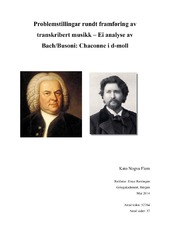| dc.description.abstract | Partita for Violin No. 2 was written by Johann Sebastian Bach during 1717-1723 and consists of five movements; Allemande, Courante, Sarabande, Gigue and Chaconne. The chaconne is longer than the rest of the piece combined, and is frequently played separately. Yehudi Menuhin calls the Chaconne "the greatest structure for solo violin that exists." (Menuhin, 1997, p. 236) Violinist Joshua Bell has said the Chaconne is "not just one of the greatest pieces of music ever written, but one of the greatest achievements of any man in history. It's a spiritually powerful piece, emotionally powerful, structurally perfect." (Weingarten, 2007) Johannes Brahms, in a letter to Clara Schumann, said that On one stave, for a small instrument, the man writes a whole world of the deepest thoughts and most powerful feelings. If I imagined that I could have created, even conceived the piece, I am quite certain that the excess of excitement and earth-shattering experience would have driven me out of my mind. (Litzman, 1979, p. 16) Chaconne is considered a big piece for the violin, but it has also been transcribed for many other instruments, including guitar, organ and piano, and is considered a demanding piece to play on these instruments as well. In my thesis I looked into the most famous transcription of this piece, one made by Italian pianist and composer Ferruccio Busoni for solo piano. I compared Busoni's version to the original version of Bach, in order to find out the effect, strengths and weaknesses and challenges when performing this transcription. Using the sheet music of Bach's original Chaconne and the sheet music of Busoni's transcription of the same piece, I analyzed it, and compared variation for variation. Not surprisingly, I concluded that some parts work better than others in Busoni's version compared to the solo violin version. I found that chords using three or even four strings on the violin tended to sound more intense than equal or even bigger chords on the piano. That means that variations consisting mostly of big chords in the violin, with the intensity kept from sustaining the chords, didn't work as well in the piano version, simply because it doesn't take nearly as much effort, and it's clear to anyone listening to it. Variations using arpeggiated chords over three or four strings in the violin also sound very natural, whereas in Busoni's version, it can easily sound a bit awkward and forced, because you actually have to struggle a lot more. However, these variations weren't written as intense variations in Bach's original, but more flowing variations, and in that sense the struggle is a bad thing. On the other hand, some variations in Busoni's transcription work really well; for example when he uses the texture possible in the piano to its full potential. Busoni takes themes from different variations and put them together in the next one, creating counterpointal effects and makes it really interesting thematically. These variations where we hear two or three themes from previous variations at the same time make it clear why this is the most famous transcription of the masterwork. The general conception of the transcription is more virtuoso, more Italian. This is mostly due to the thicker texture, and some tempo changes Busoni has written in his version. As a whole I find this transcription to work really well, and that seems to be the opinion of plenty of great pianists up to this day. Busoni's transcription of the Chaconne is now part of the standard piano literature, just as the original Chaconne is frequently performed by violinists. | en_US |
